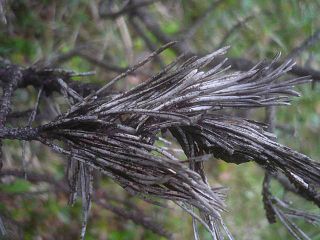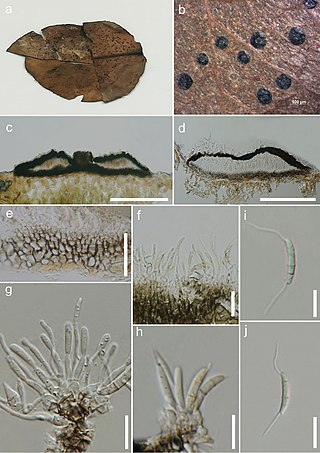Spegazzinia is a genus of widely distributed mitosporic ascomycete fungi in the family Didymosphaeriaceae.As accepted by Wijayawardene et al. 2020.

Lentinus is a genus of fungi in the family Polyporaceae. The genus is widely distributed, with many species found in subtropical regions.

Herpotrichia is a genus of fungi in the family Melanommataceae.
Byssosphaeria is a genus of fungi in the family Melanommataceae.
Paraphaeosphaeria is a genus of fungi in the Didymosphaeriaceae family. The genus has 23 species found in Europe and North America. Anamorph forms are found in the genus Paraconiothyrium. The genus was circumscribed by O.E. Eriksson in 1967.
Lasionectria is a genus of fungi in the class Sordariomycetes. It consisted of six species in 2008, and 16 in 2023.
Trichothyrium is a genus of fungi in the Trichothyriaceae family.
Phragmitensis is a genus of fungi in the Ascomycota phylum.
Ascotaiwania is a genus of fungi in the Sordariomycetes class of the Ascomycota. In 2020, it was placed in the order Savoryellales and family of Savoryellaceae.

Annulatascus is a genus of fungi in the Annulatascaceae family of the Ascomycota. The relationship of this taxon to other taxa within the Sordariomycetes class is unknown, and it has not yet been placed with certainty into any order. The genus is characterized by taxa that are saprobic on submerged, decaying plant material in freshwater habitats. Morphologically the taxa possess dark brown to black perithecia, long tapering hyaline septate paraphyses, eight-spored asci with relatively massive J- apical rings, and ascospores that may or may not possess gelatinous sheaths or appendages. There are currently 17 species included in the genus.
Chaetosphaeria is a genus of fungi in the family Chaetosphaeriaceae.
Tubeufia is a genus in the Tubeufiaceae family of fungi.
Lasiodiplodia is a genus of fungi in the family Botryosphaeriaceae. There were about 21 species. Lasiodiplodia, commonly referred to as black-soot disease, is a significant pathogen in tropical forestry.
Trichocladium is a genus of fungi within the Chaetomiaceae family.

Cordana is an ascomycete fungus genus. In 2020, it was placed within the monotypic family of Cordanaceae, and within the order Coniochaetales.
Seimatosporium is a fungus genus within the family Sporocadaceae.
Dactylaria is a genus of fungi belonging to an unknown family. According to Wijayawardene et al. 2020; the genus was placed in order Helotiales genera incertae sedis.

Dictyosporium is the type genus of fungi belonging to the family Dictyosporiaceae. By an estimate in 2018 it is formed by 45 species.

Discosia is a genus of plant pathogens in the family Sporocadaceae.





